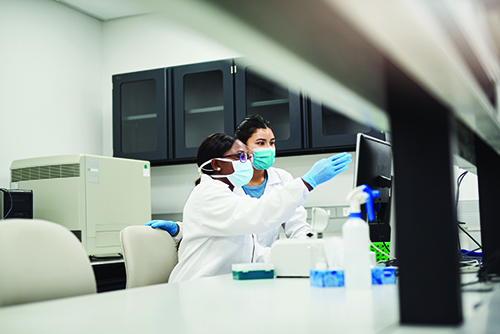
Overseeing a mass spectrometry lab is a complex task, whether you're inheriting an already established lab or starting from the ground up. Through my journey of managing a mass spec lab, I learned invaluable lessons in change management—including strategies for implementing new instruments, leading staff, and of course, patience.
One Size Does Not Fit All
Bringing in new instrumentation is something all clinical laboratorians will have to deal with sooner or later, regardless of where they start. And although I suggest meeting with as many vendors as possible in order to make an informed decision (for my schedule, that capped at three), I will stress the importance of letting your lab’s particular circumstances guide the final decision. Do you really need that extra sensitivity or resolution for your application? Is the software user-friendly? Is the instrument robust enough to handle the types of samples and the degree of “dirtiness” that you envisioned for your workflow? What type of service do you need and is the vendor you’re considering known for providing said service reliably and consistently? Do you or your staff have experience with a particular software or vendor? Does one particular instrument’s edge over the others require data storage or instrument connectivity that your hospital site does not support? No need to take the proverbial sledgehammer approach.
Aim for Duplication—In Skill and in Platforms
It may be hard to justify two of the same instruments, but it only takes one extended downtime due to an instrument malfunction to realize the value of duplicate platforms. If it’s absolutely necessary to run testing on a single platform of its kind, invest in preventative measures: Schedule additional preventative maintenance with your vendor, or train staff to perform routine instrument cleaning.
Speaking of staff, duplication in skill is also important. You never want to put all your eggs in one basket and risk losing expertise if something happens to that staff member—whether it’s a sick day, vacation, or an unexpected leave of absence. Toxicology is very manual, and it can be hard to train someone on a method when a sudden need occurs. In my lab, we have seven technologists, and we run about 40 methods. All staff rotate through all methods. This helps with changes in schedule or when any sort of flexibility is needed, such as when a physician wants to move up the day we perform testing because of a time-sensitive case.
Embrace Staff Strengths and Interests
Another benefit of having each staff member rotate through all the methods is learning about and catering to staff strengths and interests. In my lab, I aim to have a different master user for each instrument and then assign extra duties based on their strengths and interests. These additional duties might be routine “good lab citizen” duties, or small laboratory information system projects. On the flip side, laboratory leaders must also learn where improvement is needed. Early on when assigning duties, consider that each individual needs different types of support to grow, and invest in development opportunities. This contributes to morale and overall productivity.
Trust, but Verify
Every lab has its own history and different levels of experience among staff. It is a hard balance to strike between trusting that the staff are proficient at their jobs and looking out for inconsistencies or processes that could benefit from optimization. It’s important that a new lab manager doesn’t come off as distrusting or, worse, a micromanager—a style that has been proven time and time again to be the least effective. Start with curiosity: “I want to know more about how you do this,” or “Why is it that you go about this process this way and not that way?” And reassure at every point that the purpose is to improve and optimize, not criticize. Lead with questions before demanding changes to avoid giving the impression that your prior experience in another lab is better than the lab’s current processes. Trust staff experience and assume that they take pride in their work, even while keeping an eye out for ways to improve.
Rome Wasn’t Built in a Day
Lastly, try not to stretch yourself—or others—too thin from the very beginning. It will seem like there is a lot to do, and there might be a lot of things to change. In some cases, there might already be a list of projects to tackle. However, saying yes and starting all of these projects right away is a sure way to burn out both you and your staff, particularly when implementing process changes, policy changes, or bringing in new methods. When leaders ask staff to adapt to too many changes in a short period of time, people will naturally revert to what they were doing in times of stress or when days get busy. So, set realistic goals and space out changes and projects to keep everyone moving at a comfortable and sustainable pace.
Ultimately, there is no perfect recipe to running a mass spectrometry lab—one inevitably learns on the job every day, every year. Following the pointers above can enable laboratorians to hit the ground running and develop their own insights and practices faster.
Adina Badea, PhD, DABCC, is director of toxicology at Rhode Island Hospital and assistant professor of pathology and laboratory medicine at The Warren Alpert Medical School of Brown University. +Email: [email protected]